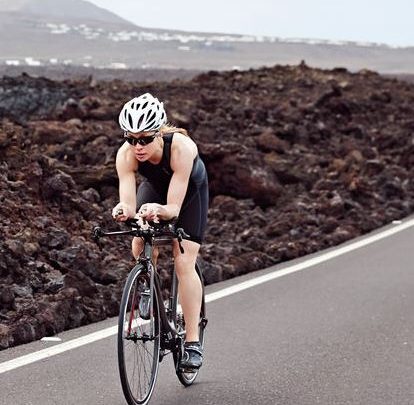Adaptation of women to long distance triathlon

The woman has her own biological characteristics that, when performing a physical activity, will affect her organism.
Our collaborator Ana Casares, tells us in this article how to adapt the training for a woman who wants to participate in a long distance triathlon.
Pedaling focused on the Valle de Buelna triathlon (Cantabria). 90 kilometers await me. The girls have left half an hour before them. A single classification is established. The first people to reach the finish line, male or female, will be the winners. 30 minutes is the time established to equate the performance of the best man with that of the best woman, in a 1.900-90-21 triathlon.
That day only a male triathlete managed to overtake me. It was in the 18 kilometer of the 21 race on foot. Exciting!
I discovered that those 32 minutes of difference in a test of 5 hours was not far from the 25 minutes that I usually get the first classified in an Olympic triathlon (1.500-40-10), duration around the 2h25.
Features
How do we adapt women to long-distance tests? Where are we and others? What aspects of women can favor them in long-distance tests?
The woman has some own biological characteristics that when carrying out a physical activity they will reverberate in your organism.
- El body weight The average of women is lower than that of men. The same happens with the percentage of water and muscle (lean mass).
- El average of fat in high-level triathletes is around an 5-9% in men and an 10-16% in women.
- The amount of muscle mass it is higher in men by an average of 40% compared to 23% in women.
- El maximum oxygen consumption (VO2 max) can be up to an 20% lower in us. The training improves the oxygen consumption but it is largely genetically determined, with which we find very variable values in the two sexes.
- La Oxygen transport capacity is inferior in us too, around an 11% less. Women have a smaller heart and a lower cardiac volume than men. These two values directly affect the performance in resistance tests.
- El respiratory system also presents differences in the woman, lung volume being a smaller 10% and the hemoglobin concentration 2 points lower approximately (from 14 to 16 in males versus 12 to 14 in women) which translates into a lower maximum oxygen consumption during the exercise.
As a counterpart, although women pump less oxygen, we are cheaper, and having a lower percentage of muscle mass our needs are lower. In the swimming segment for example, the differences between the first men and the first women are not so significant.
- La sweating It is lower in women. Your sweat glands are less developed and the heat transfer systems are different. This difference will influence athletic performance, allowing a woman to lose or gain heat more quickly.
- There are no differences between men and women in the distribution of muscle fibers.
- Women have an 10% more than elasticity, as well as ligamentous laxity and joint mobility.
And the hormones?
La testosterone, is responsible for building bones and muscles, helps regenerate connective and muscular tissue after exertion. It exerts an anabolic effect on muscle mass, bone density and strength.
The estrogen, they favor the accumulation of fat in women that is usually an 10% more than men. This becomes advantage when it comes to endurance tests. Women have a reserve of extra fat and stand out when it comes to enduring, refueling almost without stopping. Women use fat to a greater degree than men during long-term exercise. This greater oxidation of fats could improve the performance in long distance since it allows to better dose the use of carbohydrates.
The attitude
As for the attitude and character, Dr. Van Aaken tells us that the woman is much more tenacious and patient than the average man. In training it is easier to motivate and is more constant in training.
I encourage you to explore what your feminine physiology and functioning are. You will discover if you get better the shorter or longer triathlons, you will understand the responses of your organism to some training and competitions. All this will configure objectives, challenges and dreams on your way as triathletes. And you will grow as athletes and as people ...
Further information: www.actraining.es
There are no previous results.




























